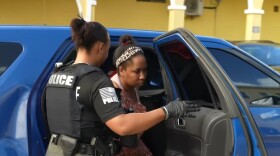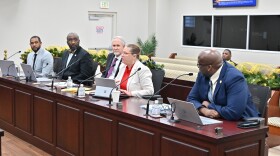ST. CROIX — The owner of a home in Estate Sion Hill has rejected a $30,000 offer from the Virgin Islands government for the taking of an easement by the authority of eminent domain to extend a nearby sidewalk and make necessary road improvements, suggesting the government should instead utilize a vacant lot across the street.
The property sits on a curve along Sion Hill Road near the entrance to Free Will Baptist Christian School. While the road leading up to the curve has been paved in both directions, the section in front of the property has massive potholes. A sidewalk parallel to the road ends when it reaches either side of the property.
Although the homeowner has declined to give up any land, the government is still in need of a permanent easement to complete its road and sidewalk project, along with a temporary easement for use during construction, according to a civil action for temporary and permanent easement the VI Department of Justice filed in Superior Court on July 12, 2022. In addition to the $30,000 offer for the permanent easement, the government has offered the homeowner $320 for temporary use of the land during the three-year construction period. The DOJ submitted a $30,320 check for deposit into the court’s registry on March 1, 2023.
The authority for the permanent easement is found in three sections of the Virgin Islands Code. The government needs 527.08 square feet of land next to the street to remove trees and a barrier consisting of 11 utility poles between 2 to 4 feet tall to construct a sidewalk and complete road improvements as part of a federally funded project.

Theresa Frorup-Alie, who owns the property with her ex-husband, Bert Scotland, indicated in her response to the complaint submitted by her attorney, Anthony Kiture, that the $30,000 appraisal was inaccurate and does not represent the current value of the property. Even if the government were to raise its offer, Frorup-Alie said she would not accept it. She is seeking dismissal of the complaint in addition to costs and reasonable attorney’s fees for the time spent in defending the action.
Frorup-Alie said she did not realize when she purchased the home 30 years ago that her property line extended about 11 feet into the road. She now has the surveyor’s map that shows the true boundaries.
“I would love for it to be resolved, and I don’t want the government to take any more of my land,” she said.
The government wants to take six feet to complete its project, Frorup-Alie said.
“That’s going to make it even more difficult for us to get in and out of our yard coming around that sharp curve,” she said.
Frorup-Alie said her house sits on a “dangerous” curve, noting that motorists have repeatedly struck a tree next to her driveway that lines the roadway. She said a safe alternative would be to convert the curve into an “L” shape, suggesting the government could utilize a vacant lot across the street from her house and relocate a nearby bank of mailboxes.
“Don’t uproot a family that has habitable property and there’s a vacant property right across the street,” she said. “It just doesn’t make sense.”

Even though the government filed its complaint two and a half years ago, the matter remains pending in Superior Court as two judges have recused themselves.
Judge Yvette Ross-Edwards recused herself in an order dated November 12, 2024. In her order of recusal, she noted a conflict of interest because she is friends with Frorup-Alie. The case was subsequently assigned to Judge Ernest Morris Jr. the next day. Morris also recused himself. The case was assigned to Judge Douglas Brady on January 29.















